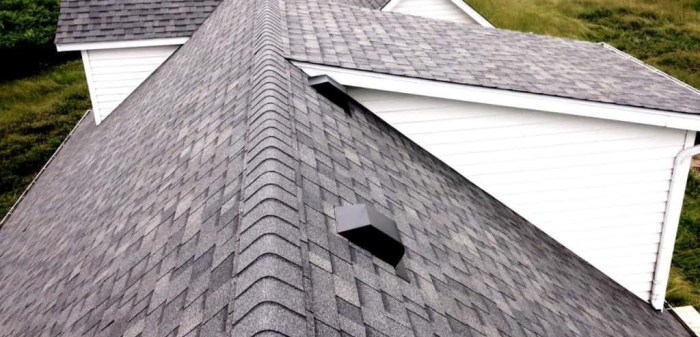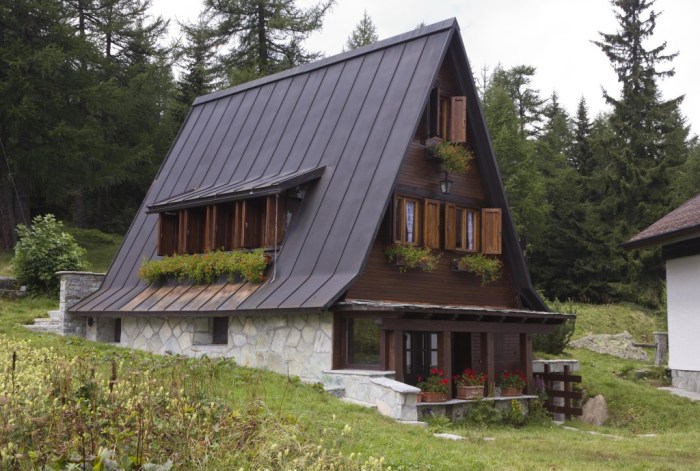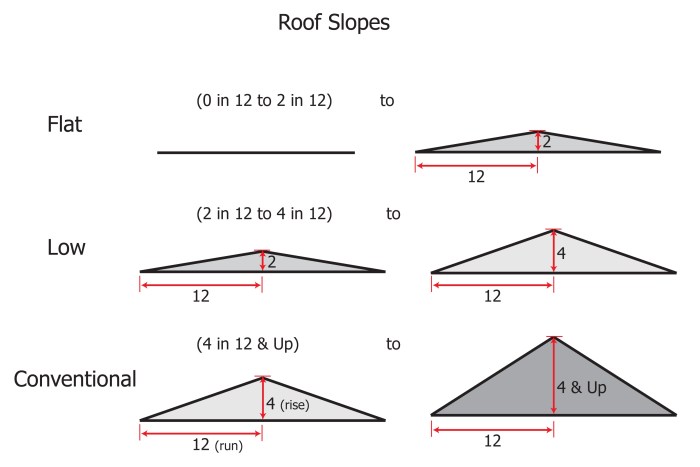Which of the following roof slope qualifies as low slope? This question sets the stage for an exploration into the world of roof slopes, their measurement, and the characteristics that define a low slope roof. By delving into the technicalities of roof slope calculations and examining the advantages and disadvantages of low slope designs, we unravel the intricacies of this crucial aspect of building construction.
1. Roof Slope Definitions

Roof slope refers to the angle at which a roof surface inclines from the horizontal. It is a crucial factor in determining a roof’s performance and appearance.
The formula for calculating roof slope is: Slope = Rise / Run, where “Rise” is the vertical distance from the roof’s base to its peak, and “Run” is the horizontal distance from the base to the point directly below the peak.
Roof slope can be measured in various units, including degrees, percent, or ratio (e.g., 4:12, meaning 4 units of rise for every 12 units of run).
2. Low Slope Roof Characteristics

Low slope roofs are characterized by a slope of less than 3:12 (or 14 degrees). They are often referred to as “flat roofs” but have a slight incline to facilitate water drainage.
Examples of low slope roof shapes include:
- Flat roofs
- Low-pitched roofs
- Shed roofs
Advantages of low slope roofs include:
- Lower construction costs
- Easier installation and maintenance
- Potential for rooftop gardens or solar panels
Disadvantages include:
- Increased potential for water ponding and leaks
- Less effective snow shedding
- Shorter lifespan compared to steeper roofs
3. Low Slope Roof Construction: Which Of The Following Roof Slope Qualifies As Low Slope

Materials commonly used in low slope roof construction include:
- Modified bitumen
- Thermoplastic polyolefin (TPO)
- Polyvinyl chloride (PVC)
- Ethylene propylene diene monomer (EPDM)
Installation techniques for low slope roofs include:
- Mechanically attached
- Fully adhered
- Ballasted
Maintenance requirements for low slope roofs include:
- Regular inspections
- Cleaning and debris removal
- Repairs as needed
4. Low Slope Roof Design Considerations
When designing a low slope roof, factors to consider include:
- Climate and weather conditions
- Building type and use
- Drainage system
- Material selection
- Installation method
To calculate the appropriate slope for a low slope roof, consider:
- Local building codes
- Rainfall intensity
- Wind speed
Tips for designing low slope roofs that are both functional and aesthetically pleasing:
- Use contrasting materials or colors to create visual interest.
- Incorporate skylights or clerestory windows to enhance natural lighting.
- Consider the surrounding environment and architectural style when selecting materials and colors.
5. Comparison of Low Slope Roofs to Other Roof Types
Low slope roofs differ from other common roof types, such as pitched roofs and flat roofs:
| Characteristic | Low Slope Roof | Pitched Roof | Flat Roof |
|---|---|---|---|
| Slope | Less than 3:12 | Greater than 3:12 | Nearly horizontal |
| Drainage | Facilitated by slight incline | Gravity drainage | Relies on internal drainage systems |
| Cost | Lower | Higher | Moderate |
| Lifespan | Shorter | Longer | Moderate |
| Maintenance | Easier | More difficult | Requires specialized equipment |
Low slope roofs are suitable for various buildings and climates, including:
- Commercial buildings
- Industrial facilities
- Residential homes in regions with low rainfall
Question Bank
What is the formula for calculating roof slope?
Roof slope is calculated as the ratio of the vertical rise to the horizontal run of the roof.
What are the advantages of low slope roofs?
Low slope roofs offer advantages such as reduced material costs, ease of installation, and improved energy efficiency.
What are the disadvantages of low slope roofs?
Disadvantages of low slope roofs include potential issues with drainage, snow accumulation, and the need for specialized materials.